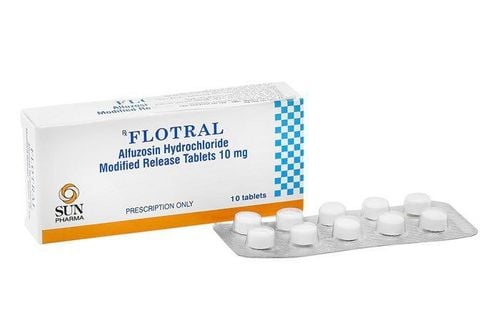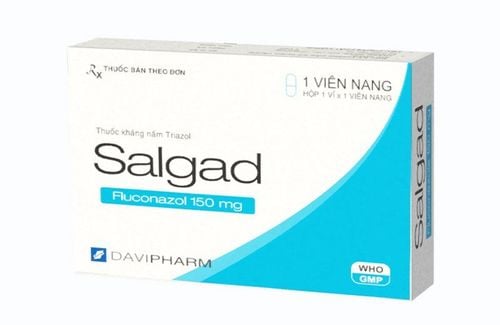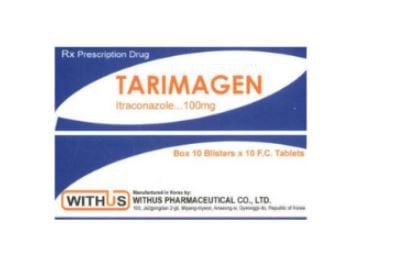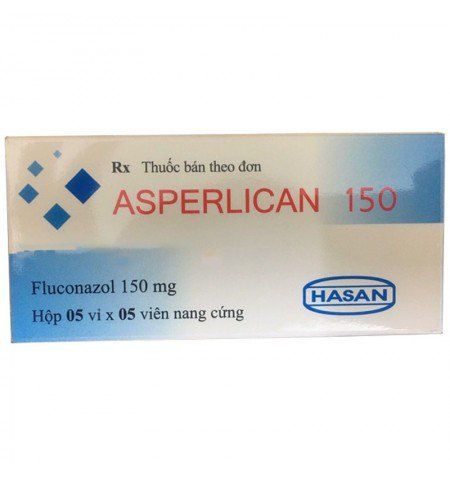This is an automatically translated article.
Odaft is a film-coated tablet with the main ingredient in each tablet being Fluconazole 150mg. So what is Odaft, what does Odaft do and how is it used?1. What does Odaft do?
Fluconazole in Odaft is the first drug in a new class of synthetic triazole antifungal drugs. Thanks to its ability to inhibit the cytochrome P450-14-α-demethylase enzyme, fluconazole inhibits the synthesis of ergosterol, the major sterol in fungal cell membranes.
As a result, it changes the permeability of the fungal cell membrane, thereby releasing essential substances (amino acids, potassium,...), and at the same time reducing the absorption of precursor molecules such as purines, pyrimidines, ... into the fungal cell. Fluconazole has no similar effect on cholesterol synthesis in humans.
Odaft is indicated in the following cases:
Vaginal - vaginal candidiasis. Candida infections of the mouth - pharynx, esophagus, peritoneum, urinary tract and serious systemic candidiasis such as candidaemia, pulmonary, disseminated candidiasis. Meningitis caused by Cryptococcus neoformans. Infections with Blastomyces, Coccidioides immitis and Histoplasma. Prophylaxis of Candida infections in immunocompromised patients, bone marrow transplant patients, patients undergoing chemotherapy or radiation therapy, cancer patients, or AIDS patients. Odaft is contraindicated in the following cases:
People with hypersensitivity to azole antifungals such as ketoconazole, miconazole and clotrimazol; or with any ingredient in Odaft. Attention and precautions when using Odaft in the following cases:
Patients with impaired liver or kidney function. Heart rhythm disturbances. The patient has a prolongation of the QT interval on the electrocardiogram. Currently, we do not have enough research on the use of Odaft in pregnant women. Therefore, Odaft should be used during pregnancy only when the potential benefit outweighs the potential risk to the fetus. The active ingredient fluconazole in Odaft is secreted into milk at concentrations similar to those in plasma, so Odaft is contraindicated in lactating women. Odaft medicine can cause headache, dizziness, so caution should be exercised when driving and operating machinery while taking this medicine.
2. Dosage and how to use Odaft
Odaft is used orally.
Dosage and duration of treatment with Odaft depend on the fungus causing the disease, kidney function and the patient's response to the drug. When treating fungal diseases, the drug should be used continuously until clinical and laboratory manifestations show that the disease is completely cured. Inadequate treatment can cause fungal infections to return.
For patients with HIV infection and cryptococcal meningitis, long-term maintenance therapy with Odaft is required to prevent recurrence.
Dosage of Odaft drug should be according to the doctor's prescription, the reference dose for specific cases is as follows:
Newborns: In the first 2 weeks after birth: Use a dose of 3 - 6mg/kg/time ; every 72 hours. From 2-4 weeks after birth: Use dose 3-6mg/kg/time; every 48 hours. Children: Prophylaxis: Use a dose of 3mg/kg/day in case of superficial fungal infections and use a dose of 6-12mg/kg/day in case of systemic fungal infections. Treatment: Use a dose of 6mg/kg/day. In cases of persistent disease, the dose of Odaft can be increased up to 12mg/kg/24 hours in 2 divided doses. Do not use more than 600mg per day. Adults: Candida infections: Vulvar and vaginal yeast infections: Use a single dose of 1 tablet (150mg)/time/day. To prevent recurrence, a dose of 1 tablet (150mg) should be used once a month for 4-12 months. Fungal infections of the mouth - pharynx: Use 1 tablet (150mg) / time / day, for 1 to 2 weeks. Fungal infections of the esophagus: Use 1 tablet (150mg) / time / day, for at least 3 consecutive weeks and use for at least 2 more weeks after the symptoms of the disease are gone. Systemic fungal infections: The first day use 3 tablets / time, the following days take 1 tablet (150mg) / time / day, for at least 4 weeks and use at least 2 more weeks after the symptoms are gone. proof. In case of cryptococcal meningitis: the first day use 3 tablets / time, the following days take 1 - 3 tablets / time / day, for a minimum of 6 - 8 weeks after a negative CSF culture test. count. For HIV-infected patients, to avoid relapse, Odaft should be used at a dose of 1 tablet / time / day for a long time. Prophylaxis of fungal infections: To prevent Candida infections in bone marrow transplant patients, use a dose of 3 tablets (450mg)/time/day. For patients predicted to have severe granulocytopenia (neutrophil count less than 500/mm3), prophylactic Odaft should be started a few days before neutropenia and continued throughout the day. Another 7 days after the neutrophil count has exceeded 1000/mm3. Patients with renal impairment: Using a single dose for the treatment of vulvovaginal candidiasis, there is no need to adjust the dose of Odaft. Patients must take multiple doses of Odaft, adjust the dose as follows: Creatinine clearance > 50ml/min: Use normal dose. Creatinine clearance 11 - 50ml/min: Use 1/2 of the normal dose. Hemodialysis patients: Use normal dose after each hemodialysis session.
3. Odaft . side effects
Common side effects of Odaft include:
Headache. Dizzy. Nausea, vomiting. Stomachache . Diarrhea. Uncommon side effects of Odaft include:
Mild transient elevation of serum transaminases and bilirubin (from 1.5 to 3 times the upper limit of normal). A rash. Itchy. Rare side effects of Odaft include:
Eosinophilia. Anemia . Leukopenia. Decrease in neutrophils. Decreased platelets. Elevated serum transaminase levels (may be up to 8 times or more above the upper limit of normal) and the drug should be discontinued. Scaly skin (mainly in AIDS and cancer patients). Stevens-Johnson syndrome. Fever. Edema. Pleural effusion. Pee less. Lower blood pressure. Hypokalemia. Anaphylaxis. If you see any unusual symptoms while using Odaft, you need to immediately notify your doctor or go to a medical facility for timely treatment.
4. Odaft drug interactions with other drugs
Odaft increases the plasma concentration of drugs such as sulfonylurea antidiabetics (glyburide, tolbutamide, glipizide), phenytoin, theophylline, astemizol, coumarin anticoagulants (warfarin), cisapride, anticoagulants viruses (zidovudine), tacrolimus and ciclosporin when used concurrently. Therefore, it is possible to increase the effects and toxicity of these drugs. Concomitant administration of Odaft and rifampicin may affect the pharmacokinetics of both drugs. Rifampicin reduces the absorption and half-life of fluconazole in Odaft, so the dose of Odaft should be increased when used concomitantly. Interactions have been reported with concomitant use of Odaft with rifabutin or Odaft with zidovudine in HIV-infected patients. Fluconazole in Odaft will increase plasma concentrations and area under the curve (AUC) of rifabutin and its major metabolites.













